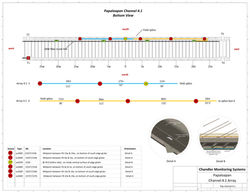
.png)
Tomorrow's Technology Today
Optical Sensing Solutions, IoT

Papaloapan Bridge

About The Bridge
The Río Papaloapan bridge is a cable-stayed type located at kilometer 85 + 980 of the Tinaja-Acayucan highway in the state of Veracruz, Mexico; It was commissioned in 1995, has a total length of 407 m, with a maximum span of 206 m and is suspended by 8 semi-harps with 14 straps each. The importance of this bridge within Mexico's federal highway network is paramount, since it allows economic exchange between the center and south of the country; Furthermore, it is a structure in which strong financial investments have been made to carry out studies and preventive maintenance during its useful life due to an inadequate construction process.
Objective
The Río Papaloapan Bridge as an ideal and strategic structure for the implementation of a continuous and real-time monitoring system in order to guarantee the safety of users and understand structural integrity over time. To achieve the proposed objectives ChM4 Inc. was contracted to Design and install a hybrid system that was composed of optical fiber FBG strain gauges, 3 axis accelerometers, single axis accelerometers, tilts, displacement sensors, 2 video cameras, a weather station and a seismological station were installed on the Papaloapan River Bridge. The sensor equipment was continuous real-time remote monitoring system powered by solar cells due to the remote location. ChM4 implemented IntelliOptics® our graphical monitoring software to receive data at a remote command and control center at IMT. The installed sensors to generate statistical distributions of the live loads present in the bridge, trend lines, calibrate mathematical models to search for global damage in the structure. IMT will make prognosis of structural integrity through Monte-Carlo simulation and calculate reliability indices of the Papaloapan River Bridge. Mexican Institute of Transportation (IMT) was trained by ChM4 to jointly install the system so their engineers would be able to implement similar systems in the future which was a success. Mexpresa provided all under bridge platforms and elevators along side pylons to install the SHM system and manpower to reposition as needed. MCH Engineering coordinated the relationships with Luna, IMT and Mexpresa for this SHM opportunity in Mexico.

Simple model built used for pre-assemble of sensor system and location approvals. The model also used in the cloud SQL user interphase software IntelliOptics®.

Sensor System Map
ChM4 designed the system to have only one DAU combining the newest optical sensors.
SHMS Optical Sensors and analog Hybrid System
SHM System:
Equipment and Sensors (1) Luna Interrogator, (1) optical multiplexer 16 channel, Luna optical sensors (24) os3610 strain sensors with onboard temperature compensation mounted to concrete bottom deck supports and pylons, (5) 0s4350 temperature absolute sensors for environmental purposes, (28) os7100 accelerometers to make up (4) triaxial and (16) single axis for stay cable signature sampling, bridge deck and pylon signatures, (8) FBG Korea tilt sensors for bridge deck and pylons, (1) Kaisen optical displacement sensors to monitor expansion joint.
Total SHM FBG optical sensors 99.
Solar Powered SHM System:
Papaloapan River Bridge, with the continuous real-time remote monitoring system is powered by 94 photovoltaic solar cells. No land power due to the remote location designed with battery banks to power at night and up to 5 days with heavy cloud cover for all devices 24/7.
Weather Station:
Analog to Fiber A/D to carry weather information to the main control panel with (1) Weatherhawk ultrasonic weather stations at the top of pylon. The environment and weather plays a roll when looking at a bridge structure and loading on the bridge deck, stay cable and pylons wind direction and speed is vital to understand sensor data.
Security Cameras and traffic monitoring:
Two Bosch cameras was used to monitor traffic and security due to the bridges remote location. Should a problem occur the camera would allow a visual inspection incase of SHM warnings or vandalism before dispatching personal.
Seismic System:
A NOMIS analog data logger and 3D Seismograph Accelerometer was used to understand how seismic activity effects the bridge structure this area exhibiting seismic activity over several years.
 |  |  |
|---|---|---|
 |  |  |
 |  |  |
 |  |  |
 |  |  |
 |  |  |
 |  |  |
 |  |  |
 |  |  |
 |  |  |
 |
ChM4 structural health monitoring installation drawings of optical sensors, on site seismic station, smart camera system, weather station, control panels, pylon platform design and software turnkey project.


IntelliOptics® structural health monitoring software, developed by ChM4 is a powerful, user-friendly interface that collects data from multiple sensor types and displays status information via one centralized program. Also see our software section for more information and our Intelli-Insight® predictive analysis module for maintenance of critical structures.
 |  |  |
|---|---|---|
 |  |  |
 |  |
ChM4 and IMT joint Installation using movable platforms hanging on trolly system provided by Mexpresa to install sensors under concrete girders and a elevator system used on pylons to install sensors, control panel, cameras, weather station at top of one pylon and the 94 solar panels mounted to pylons as shown in design drawings.